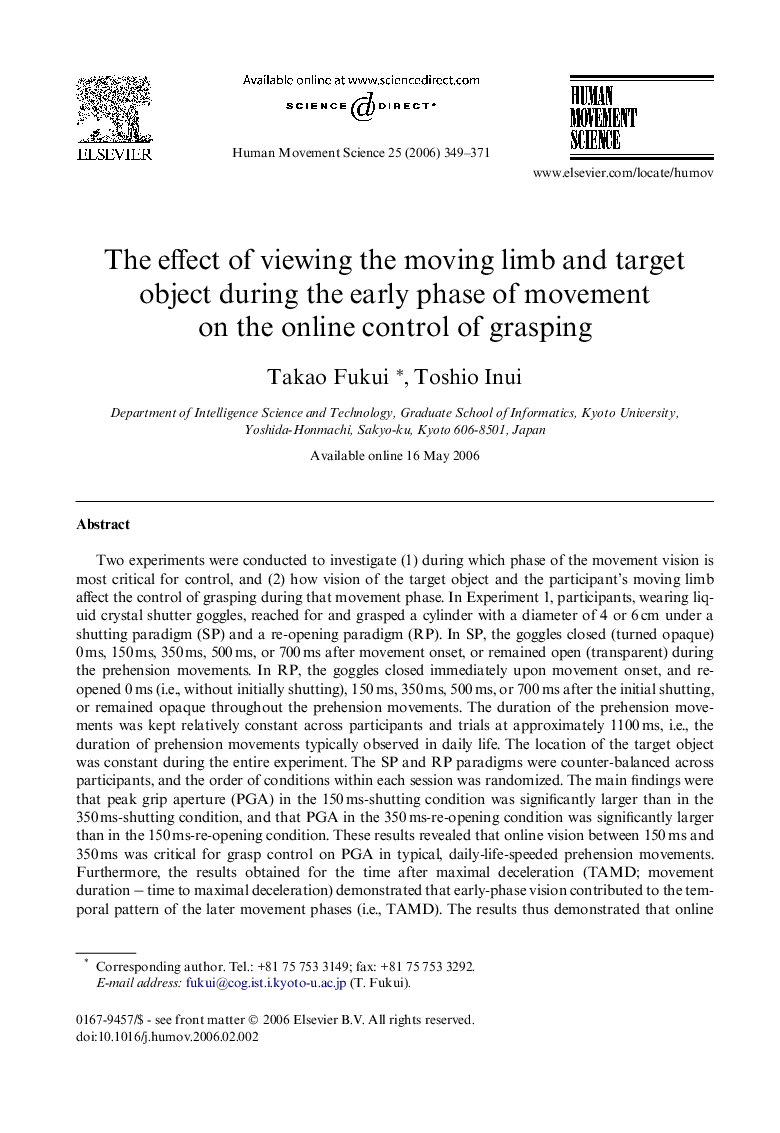| کد مقاله | کد نشریه | سال انتشار | مقاله انگلیسی | نسخه تمام متن |
|---|---|---|---|---|
| 928900 | 922405 | 2006 | 23 صفحه PDF | دانلود رایگان |

Two experiments were conducted to investigate (1) during which phase of the movement vision is most critical for control, and (2) how vision of the target object and the participant’s moving limb affect the control of grasping during that movement phase. In Experiment 1, participants, wearing liquid crystal shutter goggles, reached for and grasped a cylinder with a diameter of 4 or 6 cm under a shutting paradigm (SP) and a re-opening paradigm (RP). In SP, the goggles closed (turned opaque) 0 ms, 150 ms, 350 ms, 500 ms, or 700 ms after movement onset, or remained open (transparent) during the prehension movements. In RP, the goggles closed immediately upon movement onset, and re-opened 0 ms (i.e., without initially shutting), 150 ms, 350 ms, 500 ms, or 700 ms after the initial shutting, or remained opaque throughout the prehension movements. The duration of the prehension movements was kept relatively constant across participants and trials at approximately 1100 ms, i.e., the duration of prehension movements typically observed in daily life. The location of the target object was constant during the entire experiment. The SP and RP paradigms were counter-balanced across participants, and the order of conditions within each session was randomized. The main findings were that peak grip aperture (PGA) in the 150 ms-shutting condition was significantly larger than in the 350 ms-shutting condition, and that PGA in the 350 ms-re-opening condition was significantly larger than in the 150 ms-re-opening condition. These results revealed that online vision between 150 ms and 350 ms was critical for grasp control on PGA in typical, daily-life-speeded prehension movements. Furthermore, the results obtained for the time after maximal deceleration (TAMD; movement duration − time to maximal deceleration) demonstrated that early-phase vision contributed to the temporal pattern of the later movement phases (i.e., TAMD). The results thus demonstrated that online vision in the early phase of movement is crucial for the control of grasping. In addition to the apparatus used in Experiment 1, two liquid shutter plates placed in the same horizontal plane (25 cm above the experimental table) were used in Experiment 2 to manipulate the visibility of the target and the participant’s moving limb. The plate closest to the participant altered vision of the limb/hand, while the more distant plate controlled vision of the object. The conditions were as follows: (1) both plates were open during movement (full vision condition); (2) both plates were closed 0, 150, or 350 ms following onset of arm movement (front-rear condition: FR); or (3) only the near plate closed 0, 150, or 350 ms following the onset of the arm movement (front condition: F). The results showed that shutting at 0 and 150 ms in the FR condition caused a significantly larger PGA, while the timing of shutting in the F condition had little influence on the PGA. These findings indicated that online vision, especially of the target object, during the early phase of prehension movements is critical to the control of grasping.
Journal: Human Movement Science - Volume 25, Issue 3, June 2006, Pages 349–371